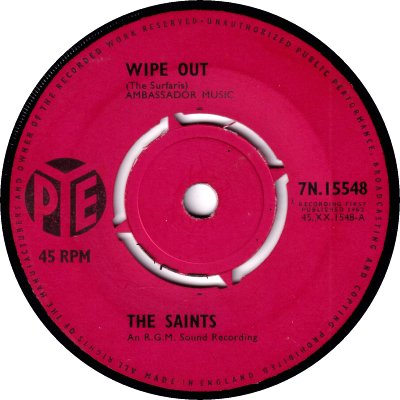



















































Pye Records was formed in 1955 as a result of the amalgamation of Alan Freeman's 'Polygon' company and Hilton Nixon's Nixa Records. Electrical distributors Pye bought shares in both companies, and a reshuffle followed, during which the Polygon label disappeared. Nixa pressed ahead under its new ownership. Initially its labels had the legend 'A product of the PYE group of companies' and 'NIXA' at the top (1), but in January 1959 this was replaced by a large 'PYE' logo with a small 'NIXA' underneath (2); the company sleeve throughout this period was rather sober (42). At the start of 1960, with 7N-15242, the 'Nixa' disappeared altogether, Pye took sole billing (3) and the sleeve got more exuberant (44). In addition to the standard purple label for Popular music on Nixa / Pye Nixa / Pye there were red and green ones for classical music. Initially Classical EPs were numbered in a NEC-23000 series (19); this seems to have been replaced by a CEC-32000 one when the 'Nixa' disappeared from the logo, though at least one NEC-23000 EP can be found on the Pye label (20) - I would guess that it was a re-pressing. As well as these red-labelled series there was a green-labelled one, which was numbered in the CEM-36000s (21).
The Trad Jazz boom of the late 1950s and early '60s was served by a dedicated black label (22, 23, 25); some copies can be found with a small logo (24). Catalogue numbers of these Jazz records were in a 7NJ-2000 block for singles, while EPs were numbered in the NJE-1000s. The black label evolved into the Pye Jazz label proper (26) around August 1961, but that lasted for only three years, disappearing at the end of 1964. Towards the end of the 1950s there was also an eight-shilling 'Pieces Of Eight' EP series (27), which was numbered in the PEP-100s and featured a variety of styles including light Classics, Blues and Christmas songs. In 1961-62 a number of records of music for ballroom dancing appeared on the Pye Strictempo label (28); these shared catalogue numbers with the Popular releases. Budget LP label Golden Guinea was responsible for two 7" EP offshoots with their own numbering (29) in 1961; the records were not available on their own but came packaged with a pair of LPs as 'The Golden Guinea Family Album'. In April 1961 the Piccadilly imprint was launched, and it kept in step with its parent until late 1967, issuing more than 400 singles in the process. It was revived briefly in 1980, too late to feature on this site. As well as signing talent from these islands, Pye looked abroad: it set up the Pye International label (q.v.) in 1958, to handle material licensed from overseas labels and from independent production companies. Two notable American concerns, Reprise and Warner Bros, came on board, in 1961 and 1965 respectively; these appeared on their own labels, as did Dot (from 1964).
Pye was a familiar name in the record business for the best part of 30 years. Lonnie Donegan was the company's biggest seller in the '50s; prominent '60s hit-makers included the Searchers, the Kinks, Sandie Shaw, Petula Clark and Donovan; while on Pye Jazz, Kenny Ball and his Band provided frequent Chart placings. Status Quo had their first hit records with Pye; David Bowie made his first singles for the company too, but they were not successful. The burgeoning 'Progressive Rock' scene of the late '60s led to Pye introducing its own Progressive label, Dawn (q.v.) in September 1969. That same year there was an attempt to crack the American market: 'Record Retailer' of the 25th of June reported that Pye had formed a joint company with American firm GRT. The new company, as yet unnamed, was intended to market Pye product in the States and to provide American material to be released in the UK. 'RR' of the 23rd of June put a name to the new company, 'Janus' (q.v.). On the business side, parent company Pye sold half of its shares in Pye Records to ATV in 1959; it sold the remainder to them in 1966 but retained the distribution network. The distribution side of things was to remain important to the company, and it handled a good number of independent labels, both big and small, in the 60's and '70s.
In the '70s a certain amount of diversification took place. 'Record Retailer' of the 24th of January 1970 revealed that Pye was going to enter the cassette tape manufacturing business, via another joint venture with GRT; the article said that the new company would be called 'Precision', and that it was expected to be up and running in April. In the event the link-up with GRT proved fairly short-lived, and the partnership broke up in May 1971. 'RR' of the 22nd of that month stated that Pye had bought out GRT's holding in Precision, and that the split had brought to an end Pye's bid for US success; despite that latter claim Pye started and ran its own US operation called Pye / ATV, which only closed at the start of 1977 ('Billboard', 8th January). With the parting of the ways Janus became wholly owned by GRT.
August 1971 saw the introduction of a 'Mini Monster' series of EPs, featuring popular 'oldies'; it was distinctive enough for me to give it its own page on this site (q.v.). All was not well, however, and 'Music Week' of the 29th of January 1972 carried the news that Pye was going to reduce its artist roster and make a bid to develop a new image for the company. According to the article 30% of Pye's artists had been let go in the past year. More consolidation followed. Pye sold its 50% stake in the Irish pressing plant Carlton Productions, preferring to either press its Irish releases in the UK or to have them custom pressed elsewhere ('MW', 8th June 1972). Four months later, Pye closed down its Irish operation completely, and turned to Polydor to handle its records in that country. Happily the attempts at getting the company back on track worked, for a while at least. May 1974 saw the launch of 'Disco Demand', a label featuring material that had proved popular in the Northern Soul discos; 'MW' of the 29th of March 1975 was able to report that the new label had been "astonishingly successful" (see 'Pye Disco Demand'). Pye also took advantage of the more general Disco boom of the second half of the decade, offering plenty of dance-orientated singles. For a while, beginning in November 1976, Pye's 'Black Music' releases on all of its labels were given a dedicated company sleeve with a picture of an umbrella on it (49) in an effort to promote that part of its output ('MW', 13th November). 1976 was a good year on the singles front for the company: the Brotherhood of Man's, 'Save Your Kisses For Me' (7N-45569) was Britain's best-selling single of that year, and the Real Thing's, 'You To Me Are Everything', on Pye International (7N-25709) also topped the Chart. The hits continued to flow in 1977, with records by the likes of the Real Thing, Meri Wilson, Carl Douglas, The Muppets and Space achieving healthy sales, while the Brotherhood of Man provided another No.1 in the shape of 'Angelo' (7N-45699). Things began to slow down in 1978: there were No.1 singles by the Brotherhood of Man again ('Figaro', 7N-46037) and by Brian & Michael with 'Matchstalk Men And Matchstalk Cats And Dogs' (7N-46035), but after a bright start to the year things tailed off. The reliable Real Thing registered in the Top 20 once and in the Top 40 twice, and Hylda Baker & Arthur Mullard's novelty version of 'You're The One That I Want' (7N-46121) almost made the Top 20; but apart from those, sales seem to have been sluggish. Things got worse in 1979: Lena Martell provided the Pye label with its final No.1, in the form of 'One Day At A Time' (7N-46021), but, apart from a couple more efforts by the Real Thing, success elsewhere proved elusive.
1980 saw the end of the Pye label as such, as the agreement which allowed Pye Records to use the Pye logo expired at the end of September that year. 'MW' of the 22nd of March 1980 was able to reveal that from the 1st of October the company would be changing its name to Precision Records And Tapes, but before the change took place there were long and serious talks between Pye Records and RCA. Initially these were about "some sort of joint operation" ('MW', 17th May), and a "joint sales and promotion force" ('MW', 24th May), but they developed into plans for a full-blown merger ('MW', 21st June). 'MW' of the 5th of July carried the news that merger terms had been agreed, but added 'many important decisions remain to be taken'. In the event some of these decisions must have been beyond agreement, for 'MW' of the 30th of August revealed that the merger was off. Magnet's Michael Levy had been poised to sell his company to RCA / Pye and was supposed to be heading the new joint company; according to 'MW' of the 6th of September he had been given firm assurances that the deal would go ahead, and he was not told about it falling through until after the news broke. In the autumn of 1980 the change of company name to Precision Records And Tapes duly took place. The Pye International label closed down completely and the main Pye label was rebranded, its owners ATV renaming it PRT. The rebranded PRT continued into the 80s and out of the scope of this site. It almost made it to the end of the decade, but not quite: it had its last Top 10 hit in 1988, with a remixed version of Petula Clark's, 'Downtown', and folded in the following year. The company's back-catalogue was sold to Castle Communications.
Pye used four different label designs for its Pop singles in the 1960s, and there were minor variations as well. In May 1960, with 7N-15627, the '45 RPM' which had been at half-past two on the first plum label (3) split up and migrated to either side of the logo (4); the occasional single had a smaller logo (5). The plum label lasted until June 1962 before being replaced by a plain pink one (6); in November of the following year several singles bore white labels for some reason (7). The plain pink label was followed by the famous pink-with-black-bar design (8) in or around January 1965. Next, in December 1967, came a rather plain powder-blue one without the round Pye logo (9). The logo returned when the old 'black bar' design was readopted in June 1968, but the powder-blue colour remained (10). The blue label lasted until April 1973, when it was replaced by a pink-fading-into-purple design. There were occasional anomalies towards the end of the blue-label era: copies of a few singles had blue printing (11); some had white labels (12), while on some copies of the last blue-and-black-labelled singles the blue turned turquoise (13). Those last two scans appear by courtesy of Robert Bowes. Initially the writing on the new pink-and-purple labels was in silver (14), but in November 1974 this was altered to black, presumably for the sake of legibility (15). The black-on-pink-and-purple label lasted until July 1979, when a white-fading-into-black label was adopted (16). Occasionally some popular singles appeared with injection moulded labels (17, 18); these were made by Phonodisc - at times when pressing facilities were overstretched it was usual for companies to have pressings done by other firms.
The earliest demo singles on Pye and its associated labels, such as Piccadilly, Warner Brothers and Reprise, had rather plain white labels and small artist credits (31); they seem to have come on the scene in early 1963. From September 1966 they were coloured yellow and were given a logo, but they kept their rather ramshackle look (32). When the design of the issue labels changed, in December 1967, those of the promos didn't change at the same time; their changeover was delayed until March 1968, and it appears to have lasted for only a month or so (33). From March 1970 promos were given the same layout as the standard labels, printing included, but they kept their yellow colouring (34); briefly, apparently around 1972, they were also given a special sleeve of their own (51). With the change to pink-and-purple labels, in 1973, standard issue labels were used, but with a large silver 'A' and the words 'NOT FOR SALE' and 'PROMOTION COPY' overprinted on them (35). In May and early June 1974 the 'A' shrank and moved to the top right-hand side of the label (36); on a couple of occasions the printing was in black (37). By the end of June the 'A' was back to its old size and was in its old position. When the rest of the printing was changed from silver to black, in October 1974 with 7N-45410, the 'A' changed as well (38, 39). Occasionally a larger, hollow, 'A' was used, during both the silver and the black days (40). The style of promo remained unchanged in 1979 when the label changed colour (41) - thanks to Ade Macrow of the 45cat site for the use of his scan. Pye was always an eager recycler of its old favourites; as well as the 'Mini Monster' EP series there was a later 'Flash Backs' one (q.v.), numbered in the FBS-0s, and, in March 1977, there came a 12" only 'Big Deal' one. The design of the company sleeves changed as the labels changed.
Numbering for the main Pye label started at 7N-15001 back in the Pye Nixa days; after 15999 it jumped to 17000 (1966); another leap followed in 1970, from 17999 to 45000. The 45000s became 46000s in the fullness of time; in 1979, around the 46250 mark, the old 7N series was replaced by a simplified, 7P-100, one, and the final link with Nixa was lost. Several Mungo Jerry singles appeared in 1970-71 with 7N-2500 catalogue numbers; these were 45 rpm issues of tracks which appeared on 33 1/3 rpm Dawn label EPs, and they may well have been intended primarily for use in jukeboxes. An example can be seen on the Dawn page; most were on Dawn but the first one was on Pye. The discography below only covers the 1970s.






Copyright 2006 Robert Lyons.

